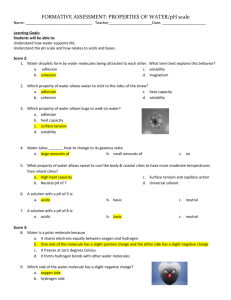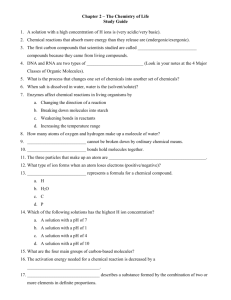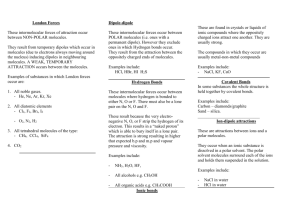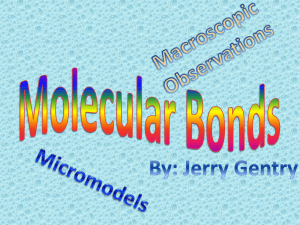1 CHM 1010 GAGE REVIEW PROBLEMS FOR SOLIDS AND
advertisement
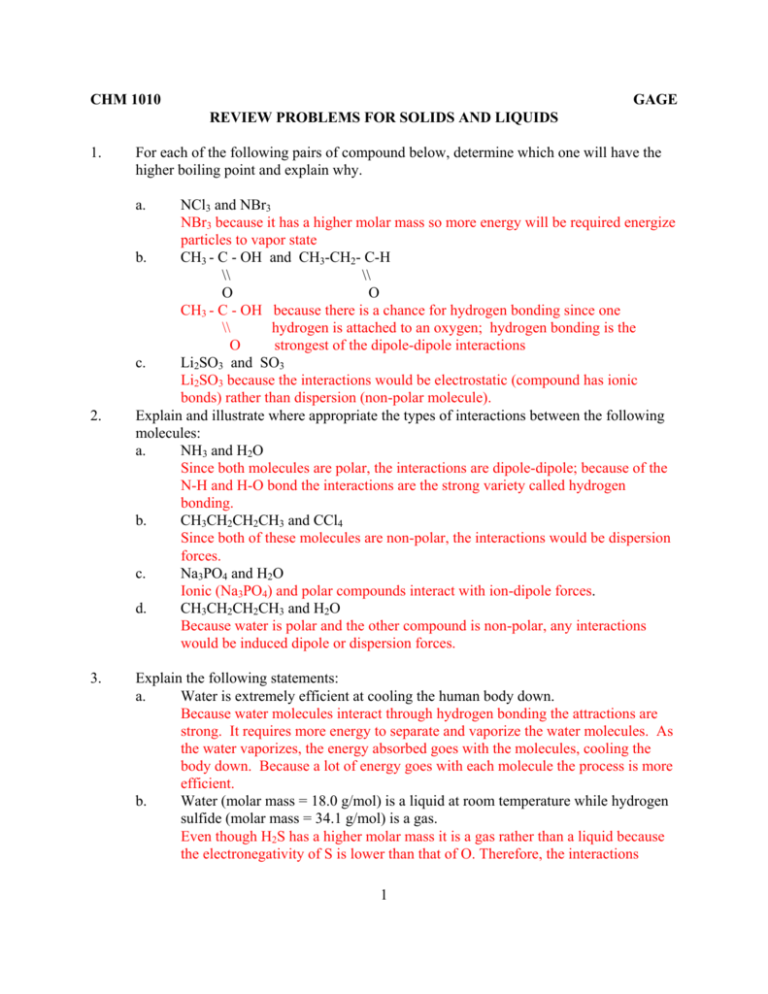
CHM 1010 GAGE REVIEW PROBLEMS FOR SOLIDS AND LIQUIDS 1. For each of the following pairs of compound below, determine which one will have the higher boiling point and explain why. a. 2. 3. NCl3 and NBr3 NBr3 because it has a higher molar mass so more energy will be required energize particles to vapor state b. CH3 - C - OH and CH3-CH2- C-H \\ \\ O O CH3 - C - OH because there is a chance for hydrogen bonding since one \\ hydrogen is attached to an oxygen; hydrogen bonding is the O strongest of the dipole-dipole interactions c. Li2SO3 and SO3 Li2SO3 because the interactions would be electrostatic (compound has ionic bonds) rather than dispersion (non-polar molecule). Explain and illustrate where appropriate the types of interactions between the following molecules: a. NH3 and H2O Since both molecules are polar, the interactions are dipole-dipole; because of the N-H and H-O bond the interactions are the strong variety called hydrogen bonding. b. CH3CH2CH2CH3 and CCl4 Since both of these molecules are non-polar, the interactions would be dispersion forces. c. Na3PO4 and H2O Ionic (Na3PO4) and polar compounds interact with ion-dipole forces. d. CH3CH2CH2CH3 and H2O Because water is polar and the other compound is non-polar, any interactions would be induced dipole or dispersion forces. Explain the following statements: a. Water is extremely efficient at cooling the human body down. Because water molecules interact through hydrogen bonding the attractions are strong. It requires more energy to separate and vaporize the water molecules. As the water vaporizes, the energy absorbed goes with the molecules, cooling the body down. Because a lot of energy goes with each molecule the process is more efficient. b. Water (molar mass = 18.0 g/mol) is a liquid at room temperature while hydrogen sulfide (molar mass = 34.1 g/mol) is a gas. Even though H2S has a higher molar mass it is a gas rather than a liquid because the electronegativity of S is lower than that of O. Therefore, the interactions 1 c. d. e. 4. between hydrogen sulfide molecules are weaker than those between water molecules (hydrogen bonds) and it is easier to vaporize. Why is water a liquid at room temperature while ammonia is not? The electronegativity of O is higher than that of N so the H-O bond is more polar than the N-H bond. As a result, there are stronger hydrogen bonds between water molecules than between ammonia molecules. As you boil water you notice bubbles at 30oC and more at 100oC. What are the bubbles in each case? Explain why you see them. The first bubbles to form are probably dissolved gases such as carbon dioxide and oxygen but they might also be formed from water vapor. As the temperature increases more water molecules enter the gas state and the bubbles are composed of water. Do you want a throat medication to have a high or low surface tension? Explain. Since you would like a throat spray to coat the surface and not bead up, you would like the material to have a low surface tension. Based on the descriptions below, classify each solid as: molecular; network; ionic; amorphous; or metallic. Explain why. a. b. c. d. A soft, slippery solid that has no definite melting point but decomposes at temperatures above 250oC and does not conduct electricity. Since the material is soft, slippery and has no definite melting point it is probably an amorphous solid. A hard solid that melts at 3410oC; both the solid and liquid state conduct electricity. Since both states conduct it must be a metallic solid. Violet crystals that melt at 114oC; its vapors irritate the nose; neither the solid nor liquid conducts electricity. This material has a relatively low melting point and does not conduct so it is a molecular crystal. Hard, colorless crystals that melt at 2800oC; the liquid conducts electricity but the solid does not. Since the liquid conducts but not the solid it must be an ionic solid. In the liquid state the ions are free to move and conduct charge. 2 5. Air conditioners currently use one of the "freons" as a heat transfer medium (although they will soon be phased out). The freon with the formula CCl2F2 has a normal boiling point of -30oC and a heat of vaporization of 165 J/g. The gas and liquid have specific heat capacities of 0.61 J/g$K and 0.97 J/g$K respectively. How much heat will be transferred when 80.0 g of this freon are cooled from +45oC to -45oC? The freon is starting as a gas and cooling to a liquid so this will be a three stage process/problem. Since the size of a Kelvin is the same as a degree Celsius you can use the change in K the same as the change in oC. 0.61 J Gas cools E1 = sp ht gas x ΔT x g = x 75 K x 80.0 g = 3700 J (2 sf) gK 165 J Gas → Liquid E 2 = ΔH vap x g = x 80.0 g = 13200 J (3 sf) g 0.97 J Liquid cools E 3 = E1 = sp ht liq x ΔT x g = x 15 K x 80.0 g = 1200 J (2 sf) gK E Total = E1 + E 2 + E3 = 3700 + 13200 + 1200 = 1.80 x 104 J 6. Predict whether the following substances will have high or low melting and boiling points and explain why: O2 Low because it is non-polar and the IMFs would be weak dispersion forces that require less energy to overcome and therefore changes will occur at lower temperatures. Diamond Very high because this a covalent crystal with all atoms linked by strong covalent bonds. A large amount of energy will be needed to overcome the bonds and allow the atoms to move independently. potassium chloride Very high because this is an ionic compound and it will take a large amount of energy to overcome the electrostatic attractions. carbon dioxide Low because this is compound forms a molecular crystal and the forces between molecules in the lattice and liquid are more easily overcome. 3





